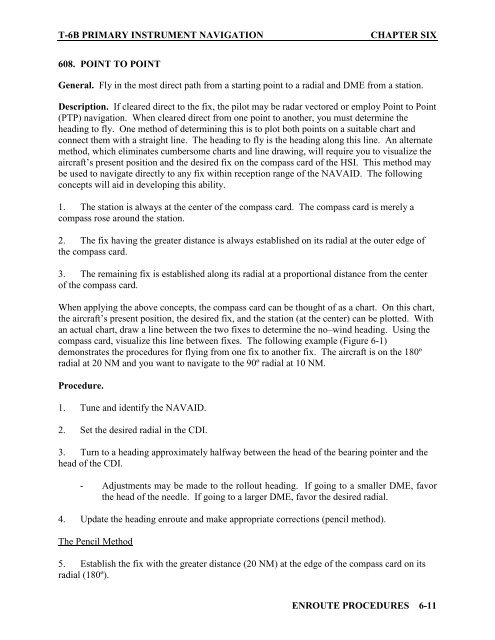Flight Training Instruction - Cnatra - U.S. Navy
Flight Training Instruction - Cnatra - U.S. Navy
Flight Training Instruction - Cnatra - U.S. Navy
Create successful ePaper yourself
Turn your PDF publications into a flip-book with our unique Google optimized e-Paper software.
T-6B PRIMARY INSTRUMENT NAVIGATION CHAPTER SIX<br />
608. POINT TO POINT<br />
General. Fly in the most direct path from a starting point to a radial and DME from a station.<br />
Description. If cleared direct to the fix, the pilot may be radar vectored or employ Point to Point<br />
(PTP) navigation. When cleared direct from one point to another, you must determine the<br />
heading to fly. One method of determining this is to plot both points on a suitable chart and<br />
connect them with a straight line. The heading to fly is the heading along this line. An alternate<br />
method, which eliminates cumbersome charts and line drawing, will require you to visualize the<br />
aircraft’s present position and the desired fix on the compass card of the HSI. This method may<br />
be used to navigate directly to any fix within reception range of the NAVAID. The following<br />
concepts will aid in developing this ability.<br />
1. The station is always at the center of the compass card. The compass card is merely a<br />
compass rose around the station.<br />
2. The fix having the greater distance is always established on its radial at the outer edge of<br />
the compass card.<br />
3. The remaining fix is established along its radial at a proportional distance from the center<br />
of the compass card.<br />
When applying the above concepts, the compass card can be thought of as a chart. On this chart,<br />
the aircraft’s present position, the desired fix, and the station (at the center) can be plotted. With<br />
an actual chart, draw a line between the two fixes to determine the no–wind heading. Using the<br />
compass card, visualize this line between fixes. The following example (Figure 6-1)<br />
demonstrates the procedures for flying from one fix to another fix. The aircraft is on the 180º<br />
radial at 20 NM and you want to navigate to the 90º radial at 10 NM.<br />
Procedure.<br />
1. Tune and identify the NAVAID.<br />
2. Set the desired radial in the CDI.<br />
3. Turn to a heading approximately halfway between the head of the bearing pointer and the<br />
head of the CDI.<br />
- Adjustments may be made to the rollout heading. If going to a smaller DME, favor<br />
the head of the needle. If going to a larger DME, favor the desired radial.<br />
4. Update the heading enroute and make appropriate corrections (pencil method).<br />
The Pencil Method<br />
5. Establish the fix with the greater distance (20 NM) at the edge of the compass card on its<br />
radial (180º).<br />
ENROUTE PROCEDURES 6-11
















